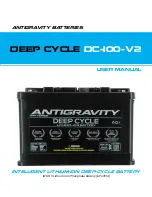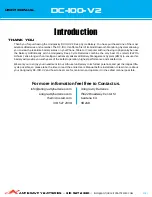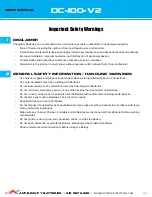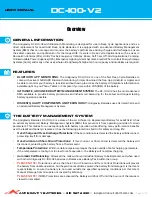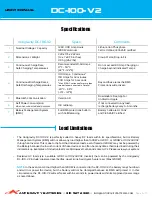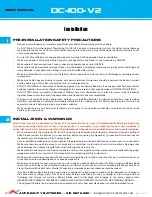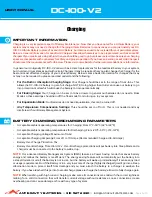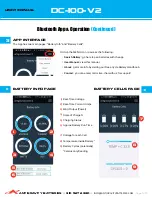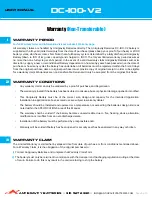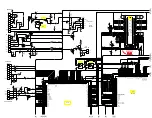
DC-100-V2
ANTIGRAVITY BATTERIES
//
310 527 2330
//
INFO@ANTIGRAVITYBATTERIES.COM
Page 5 of 9
USER MANUAL
Charging
IMPORTANT INFORMATION
Charging is a very important aspect of Battery Maintenance. Now that you have opted for a Lithium Battery, your
system may or may not need a change for Charging Lithium Batteries. In many cases you can just install your DC-
100-V2 Lithium Battery in place of a Lead/Acid Battery, but this does need to be reviewed for your particular system.
Below is General Information for Lead/Acid Chargers that allow themselves to be programmed, such as some RV
chargers. If you are already using Lithium then you should be good to go, but please review to make sure your charging
specs are compatible with our battery for safety and proper operation. If you have an existing Lead/Acid Charger it
should meet the requirements set forth below. Please visit our website for further recommendations or information.
In general our Antigravity DC-100-V2 can work as a direct replacement for the lead/acid battery in your system,
but in certain circumstances and with certain Chargers it may be required that you also change the Charger for the
best and most effective charging of your Lithium battery. Below is some basic information for changes that may
or may not be required. So please read and understand the following:
• For the Bulk or Absorption Charging Stage:
Your Charger should be set in the range of 14.2v~14.6v. This
allows the DC-100-V2 battery to get a full charge. NOTE: Going higher than 14.8v can cause our battery to go
into protection mode which will cause the battery to not operate normally.
• For Floating Stage:
Your Charger can be set to 13.6v or lower. In general our batteries do not need a Float
Mode so these settings should turn off the float mode from turning on in your system.
• For Equalization Mode:
Our Batteries do not need Equalization, this can be turned off.
• Any Temperature Compensation Settings:
This should be set to off or 0. This is not needed and may
interfere with our Battery Management System.
BATTERY CHARGING/DISCHARGING PARAMETERS
•
Acceptable ambient operating temperatures for Charging: From 0°C~50°C (32°F~122°F)
•
Acceptable ambient operating temperatures for Discharging: From -20°C~55°C (-4°F~131°F)
•
Acceptable Charging Voltage: Maximum of 14.6V
•
Acceptable Charging Amperage: From 20 to 70 Amps. (Recommended Charge at 45-60Amps)
•
Battery Over-Charge Protection: 15v
•
Battery Over-Discharge Protection: 11.2v - Over-Discharge protections will put battery into Sleep Mode and a
charger must be connected to the battery to wake it up.
NOTE:
Our advanced Battery Management System (BMS) features a Power Saving mode that saves battery
energy and makes the battery more efficient. The energy saving feature will automatically put the battery into
a sleep/dormant mode if the battery is not in use, but the battery will wake up immediately if it senses any load
or usage requirements. But if the Battery is in a very low state of charge (highly discharged) it will go into a Deep
Hibernation mode to protect itself from damage and you must attach the battery to a charger to awaken the
battery. If you have reached this point of over-discharge please recharge the battery; allow it to fully charge again.
NOTE:
When working with high current charging, make sure all connections are solid with the correct tightness
making for a solid connection that will transfer current/voltage without resistance. Loose connections create
overheating and can cause damage or fire with any type of system.
i

